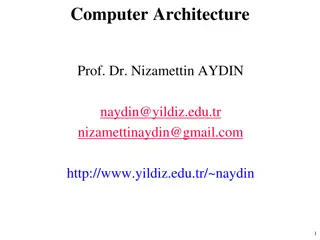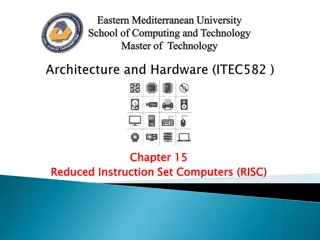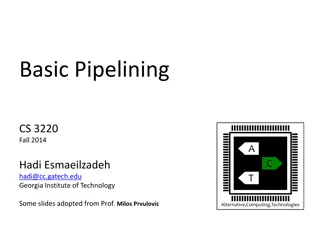Understanding Computer Architecture: CPU Structure and Function
Delve into the intricate world of computer architecture with Prof. Dr. Nizamettin AYDIN as your guide. Explore topics such as CPU structure, registers, instruction cycles, data flow, pipelining, and handling conditional branches. Gain insights into the responsibilities of a CPU, internal structures,
0 views • 39 slides
Evolution of Computing Architectures: RISC Approach
Study on the RISC approach in computing architecture, focusing on key characteristics and advancements since the inception of stored-program computers. Topics covered include the family concept, microprogrammed control units, cache memory, pipelining, and the development of RISC architecture as an a
0 views • 58 slides
FPGA Accelerator Design Principles and Performance Snapshot
This content explores the principles behind FPGA accelerator design, highlighting the extreme pipelining via systolic arrays that enables FPGAs to achieve high speeds despite lower clock frequencies compared to CPUs and GPUs. It delves into the application of Flynn's Taxonomy, performance snapshots
0 views • 17 slides
Understanding Pipelining in Computer Architecture
Pipelining in computer architecture involves overlapping fetch-execute cycles to process multiple instructions concurrently. It utilizes stages, latches, and throughput to enhance CPU performance. Different forms of pipelining, stage-related terms, and the transition from non-pipelined to pipelined
0 views • 64 slides
Understanding Basic Pipelining in Computer Science
Exploring the concept of basic pipelining in computer science, focusing on a two-stage pipeline and key decisions involved in the process. The discussion covers pipeline stages, memory handling, control decisions, Verilog implementation, and keeping the design simple to understand and implement effe
0 views • 29 slides
Enhancing Erasure-Coded Storage with Repair Pipelining
Erasure coding is a powerful redundancy technique for distributed storage systems, offering fault tolerance and reduced redundancy compared to replication. This paper discusses the concept of erasure coding, its practical applications, and challenges such as repair penalties. It explores innovative
0 views • 21 slides
Understanding Pipelining in Computer Organization
Explore the intricate process of pipelining in computer organization and assembly language programming. Delve into the fetch-decode-execute cycle, toy ISA instructions, defining pipeline behavior, and the pipeline steps for different instructions. Gain insights into how instructions progress through
0 views • 37 slides
Introduction to Parallel Computing Concepts
Exploring the concepts of threads, pipelining, and dependence in parallel computing. Discussions on why multiple threads are beneficial, pipelined instructions, and the challenges of dependencies in executing instructions sequentially. Delve into Simultaneous Multithreading (SMT) and its advantages
0 views • 9 slides
Understanding Processor Structure and Function in Computing
Explore the key components and functions of processors in computing, including user-visible and control status registers, instruction cycle, instruction pipelining, processor tasks like data processing and instruction interpretation, and the roles of arithmetic and logic units and control units. Lea
0 views • 61 slides
Understanding Pipelining in Computer Organization
Pipelining is a crucial concept in computer organization that involves organizing hardware to execute multiple operations simultaneously, akin to an assembly line. By overlapping different tasks for various instructions, the overall speed of program execution is enhanced. This technique divides the
0 views • 53 slides
Parallel and Vector Processing Techniques in Computer Systems
Understanding parallel and vector processing is essential for enhancing computational speed and throughput in computer systems. Parallel processing involves executing multiple tasks simultaneously to increase processing capability. Pipelining divides processes into sub-processes for efficient execut
0 views • 28 slides
Overview of Single-Cycle Implementation in Computer Organization
Today's lecture discussed the single-cycle implementation of processors, focusing on executing instructions in hardware based on the ISA. The process involves different cycles such as instruction fetch, decode, execution, memory access, and write-back. The presentation highlighted the functions of a
0 views • 24 slides
Exploring Content Distribution Networks (CDNs) and Efficient Transfer Protocols
Delve into the world of Content Distribution Networks (CDNs) with insights on maximizing goodput, handling multiple requests efficiently, challenges with pipelining, and advancements like Google's SPDY and HTTP/2 for enhanced content delivery over the web.
0 views • 43 slides
Understanding Pipelined Implementation in Computer Architecture
Learn about the general principles of pipelining, challenges in creating a pipelined Y86-64 processor, real-world pipeline examples like car washes, computational examples, 3-way pipelined version details, pipeline diagrams, operating a pipeline, and limitations of pipelining. Explore topics such as
1 views • 32 slides
Understanding Pipelined Implementation in Computer Architecture
This resource delves into the concepts of pipelining in computer architecture, exploring the general principles, real-world analogies, computational examples, and the operation of a pipeline. It covers the difficulties in creating pipelined processors, handling data and control hazards, and showcase
0 views • 32 slides
Understanding Laundry Pipelining and Digital Circuits
Explore the concept of pipelining through laundry examples and digital circuits. Learn how pipelining can improve throughput and reduce latency in processing tasks. Discover the benefits of pipelining in achieving more work done in less time.
0 views • 14 slides















